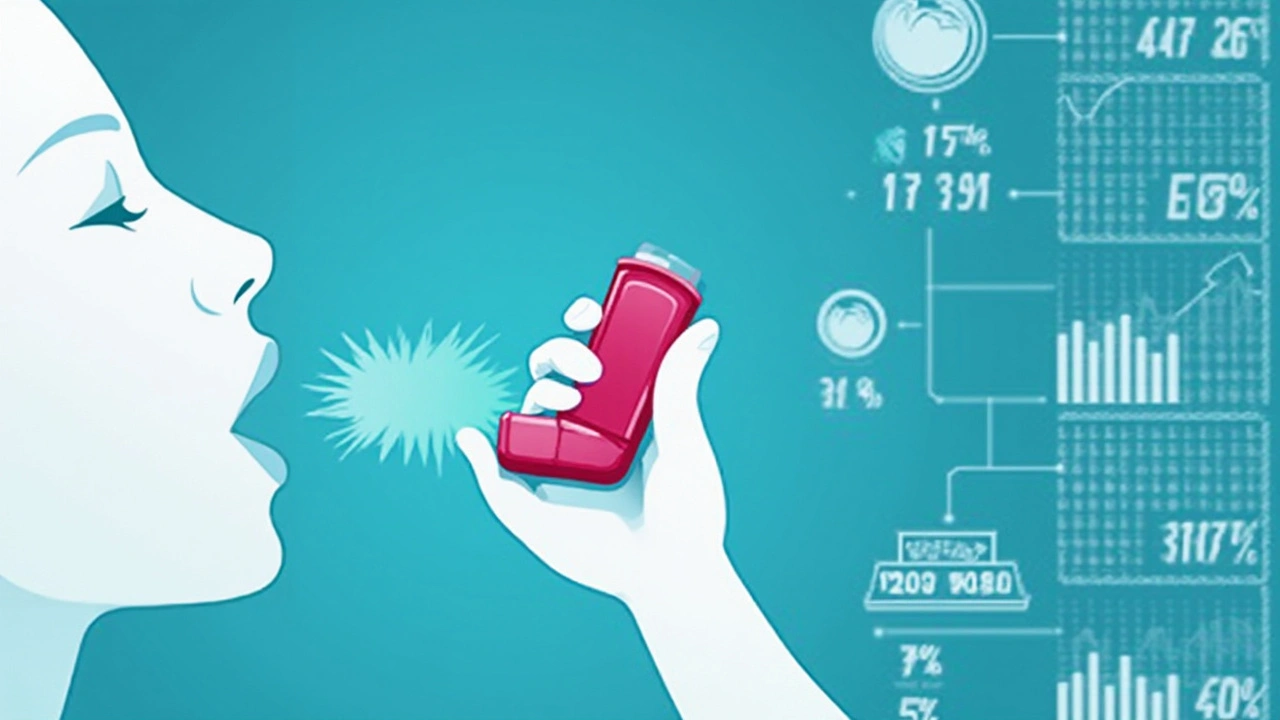 10
Jun,2025
10
Jun,2025
Here’s a scene most folks with asthma know by heart: wheezing, chest tightness, and suddenly scrabbling for that little blue inhaler. Albuterol isn’t just another prescription—it can mean the difference between panic and relief. But what actually happens when you puff albuterol, and are you using it the right way? Let’s get into what makes this inhaler tick and why it’s such a game-changer for millions.
How Albuterol Works and When It’s Used
Albuterol sits at the heart of asthma and COPD management. When airways suddenly clamp down during an asthma attack, breathing feels like trying to sip a milkshake through a coffee stirrer. Albuterol steps in fast, relaxing those tight muscles around your airways, making it easier for air to rush in and out. Most albuterol inhalers start easing symptoms in about five minutes—sometimes even faster. That’s why folks call it a “rescue” or “reliever” inhaler.
This stuff isn’t just for asthma, either. It’s a lifeline for people with chronic obstructive pulmonary disease (COPD), exercise-induced bronchospasm, certain allergies, or other quick-onset breathing crises. Anywhere spasms close down the bronchial tubes, albuterol (also sold under names like ProAir, Ventolin, and Proventil) plays hero. But just because it works fast doesn’t mean you should reach for it constantly. If you’re using it more than twice a week outside of planned exercise, that’s a red flag your underlying condition might not be under control.
Here’s a wild fact: An average albuterol inhaler contains about 200 shots—or “puffs.” If you’re refilling every month or two, you’re likely relying on it too frequently. According to a 2023 study from the American Lung Association, people who used albuterol more than three times a week were 50% more likely to have poorly controlled asthma than those who used it less. It’s worth keeping track—jotting down every time you use your inhaler (in your phone or a tiny notebook) goes a long way to help your doctor tweak your plan.
Nobody likes being the person who can’t keep up with friends on a hike because of wheezing. Kids, teens, and adults all use albuterol, but the proper administration and dosage can look different based on age, underlying conditions, and delivery device (metered-dose inhaler, nebulizer, or dry powder inhaler). The golden rule: always take your med exactly as your doctor prescribes. Doubling up on doses to “make up” for a missed one or sharing inhalers can make things worse.
Quick tip: Before using a new inhaler, always prime it by spraying a few puffs into the air. It helps make sure the medicine is delivered right. Store it dry, keep it at room temp, and check that expiration date—that old inhaler in the back of your backpack might not have any power left when you need it most.
Albuterol is a beta-2 agonist. That means it targets specific receptors in your lung muscles, causing them to relax. It doesn’t treat the underlying inflammation in your airways, though—that’s a job for other meds like steroids. This is why albuterol shouldn’t be used as your only asthma control. Think of it as the spare tire, not the steering wheel.
When in doubt, remember what the Centers for Disease Control and Prevention (CDC) says: “Daily reliance on quick-relief inhalers may be a signal of poorly managed asthma.” That’s a wake-up call for a medication check-in with your provider.
| Albuterol Inhaler Facts | Details |
|---|---|
| Brand Names | ProAir, Ventolin, Proventil, AccuNeb |
| Onset of Action | 3-5 minutes |
| Duration of Action | 4-6 hours |
| Common Doses | 2 puffs every 4-6 hours as needed |
| Age Range | Approved for children 4 years and up |
| Annual Prescriptions (US, 2023) | ~50 million |

Common Side Effects and Safety Tips
You puff, you feel your chest relax, but suddenly there’s jitteriness, or your heart feels like it’s pounding a bit quicker—yep, those are normal side effects with albuterol. That “shaky hands” feeling happens because this drug doesn’t just stick to your lungs. A tiny bit reaches the bloodstream and can crank up adrenaline-like effects. For most, it settles down in 15 to 30 minutes. If you gulp down a large dose or use the inhaler too often, those shakes or heart flutters can get worse, sometimes leading to headaches, nervousness, or even mild insomnia.
Here’s a quick breakdown of the most common side effects:
- Shakiness or tremors (happens in about 10-20% of patients)
- Faster heartbeat, or palpitations
- Headaches
- Feeling a bit wired or anxious
- Mild throat irritation or cough
- Muscle cramps, especially if using high doses or a nebulizer
- Rare: Nausea, dizziness, or low potassium levels (most likely if using more than recommended)
The most serious risk comes when people ignore these early warning signs and keep piling on more puffs. Overuse can put stress on your heart, especially if you already have heart problems. There have been rare cases of chest pain or rhythm disturbances, so it’s smart to combine common sense with your doctor’s advice. And don’t be shy—if you feel symptoms like chest tightness, fainting, or your usual dose isn’t working anymore, get help right away. Emergency rooms see people all the time who talk themselves out of getting care until things go sideways.
A lot of people miss that you should rinse your mouth out after using a metered-dose inhaler. This isn’t just a suggestion—leftover medicine can irritate your mouth or throat. If you use a spacer (a small plastic tube for easier inhalation), it cuts down on wasted spray and helps you get more of the good stuff into your lungs. In fact, studies show spacers can boost delivery efficiency by up to 60% compared to inhaling straight from the device.
Younger kids might struggle with the timing and technique. For them, doctors usually recommend a mask attachment or nebulizer—a machine that turns liquid albuterol into a mist (super helpful for little ones and folks who don’t have the hand-breath coordination thing down). Either way, reviewing your technique with a doctor or nurse every so often is smart. Lots of people use their rescue inhalers wrong and never realize it.
Most folks can tell the difference between their usual albuterol jitters and signs that something isn’t right. But here’s what not to brush off:
- Worsening shortness of breath, even after using albuterol
- Needing it more than every four hours
- Repeated nighttime symptoms
- Lips or fingers turning bluish
- Chest pain that makes you stop what you’re doing
If any of those pop up, time to call your provider or head to the ER. The line between “manageable” and “emergency” can be quick and blurry—better to err on the safe side.
Here’s a great tip from the Asthma and Allergy Foundation of America: mark your calendar when you open a new inhaler. Set a reminder to check it at the two-month mark, even if you don’t think you’re close to running out. A major study found that 25% of ER visits for asthma happen because people ran out or had empty inhalers when they needed them.
As the Mayo Clinic reminds us,
“Albuterol is very effective for quick relief, but if you're needing it too often, that may be a warning signal for a deeper problem with airway inflammation.”
Take that seriously and bring it up at checkups, so your doctor can help keep you safe and breathing easy.

Albuterol Tips, Tech, and Mistakes Everyone Makes
Let’s be honest, most people get a prescription and don’t get much real-world coaching on using it. You’d be surprised how many folks mess up the technique—either spraying the inhaler into their mouth (instead of inhaling at the right moment) or missing a step and wasting half the dose.
Here’s the gold standard method for using a metered-dose albuterol inhaler (the classic canister type):
- Shake the inhaler every time before a dose.
- Breathe out all the way, getting your lungs empty.
- Place the mouthpiece in your mouth (make a tight seal with your lips).
- As you start to breathe in slowly (over about 2-3 seconds), press down firmly on the canister to release medicine.
- Keep inhaling slowly and deeply, letting the medicine travel deep into your lungs.
- Hold your breath for about 10 seconds to let the medicine soak in.
- Exhale gently.
- Wait at least one minute before a second puff (if prescribed).
A spacer is your best friend if you struggle with hand-breath coordination. Pop the inhaler into one end, breathe in through the other; no mad timing needed. If you use a dry powder inhaler (like ProAir RespiClick), you’ll skip the shake-and-press routine and just take a deep breath through the device.
One mistake? Skipping maintenance meds. Steroid inhalers or combination inhalers may feel like overkill when you “feel fine,” but skipping them can leave airways angry and raw, meaning albuterol has to work even harder next time. It’s teamwork—your controller meds reduce inflammation, albuterol kicks in during flares.
Technology has actually stepped up the asthma game. These days, you can find “smart” inhalers with built-in sensors that track when you use each puff. They sync to your phone and create shareable reports for your doctor, so nobody’s left guessing how often albuterol is needed. Some insurance companies even give discounts for using them because better management means fewer ER trips.
If you’re wondering about generics, good news: generic albuterol inhalers work just as well as the big brands. The FDA approved several in the last two years, knocking prices down from $60–$70 a unit to as little as $20 for some plans or pharmacies. Always check with your doctor or pharmacist about what will be covered and if there’s any switch in how it’s used.
One last tip: don’t ever chuck an inhaler straight in the trash, even when it’s empty. Spray canisters can explode if crushed or burned. Most pharmacies will take old inhalers for safe disposal, or check local hazardous waste guides. Clean up your med routine—and the earth at the same time.
Albuterol isn’t just a breath of fresh air—it’s a tool that, used right, can make life normal again for people with asthma and similar conditions. If you treat it as a backup, learn the technique, and talk about any changes with your healthcare team, you get freedom, not just relief.






Honestly, this whole hype about albuterol is a bit overrated if you ask me. Sure, it opens up airways, but it's not some miracle drug that fixes everything. People rely on it too much without considering the side effects. From jitteriness to heart palpitations, it’s like a ticking time bomb for some users. Why not focus more on prevention and lifestyle changes instead of popping that inhaler every time you feel a bit wheezy?
I get that emergencies happen, but overuse can seriously mess with your health. And don't get me started on how some folks treat it like candy, inhaling doses more than prescribed. Have we really learned nothing?
To dive deeper into your concerns, it's crucial to recognize the pharmacodynamics of albuterol. The short-acting beta-2 adrenergic receptor agonism indeed precipitates bronchodilation, but this specificity limits systemic side effects when administered correctly. The jitters and palpitations you mentioned arise from transient beta-1 receptor cross-stimulation, which can sometimes be mitigated with optimized dosing strategies.
While prevention and non-pharmacological interventions are paramount, dismissing albuterol's role in acute management undermines evidence-based protocols endorsed by pulmonary specialists. The idea that overuse is rampant neglects to address patient education, inhaler technique, and underlying disease control.
So, blaming the drug without contextualizing physiological and therapeutic parameters misses the mark. Curious to hear more about your basis for advocating lifestyle changes over inhalation therapy.
I appreciate the detailed explanation, but honestly, most patients aren’t getting perfect education or proper technique. In the real world, people misuse inhalers, and that’s the problem. Clinical data is great, but patient behavior varies wildly.
My point is more about raising awareness that this isn’t a ‘set it and forget it’ kind of medicine. We need stronger emphasis on proper training and alternative symptom management strategies. Asthma control isn’t just about puffing a canister.
It’s true that proper usage is key, but let’s not throw the baby out with the bathwater here. Albuterol has saved countless lives by providing quick relief during asthma attacks. While side effects exist, they are generally manageable and outweighed by benefits in emergencies.
Also, lifestyle modifications and trigger avoidance are ongoing battles. Sometimes, you just need that rescue inhaler to get through a tough episode. I think balance is essential — use albuterol smartly alongside preventive care.
This post is really informative. I love that it breaks down when and when not to use albuterol because so many people just rely on it without understanding the consequences. I suffer from asthma, and I learned the hard way that overusing the inhaler can cause more trouble than help.
It’s nice to see tips and stats in one place. I think posts like this really help those of us dealing with breathing problems to manage better. Would like to know more about how to avoid common mistakes with using the inhaler.
Your experience definitely highlights the necessity of balancing symptom control with safe inhaler use. I often wonder if improved access to respiratory therapists could reduce misuse issues. Often, patients are discharged with inhalers but minimal training.
Perhaps healthcare systems should emphasize ongoing patient education, as understanding the pharmacology of albuterol and its side effects can empower users to act responsibly. Are there any specific mistakes you think are most common or harmful?
Great question. I think the biggest mistake is relying on albuterol as a daily fix instead of preventive medication. Many people skip their controller meds because they feel fine and just use albuterol when symptoms flare. That’s dangerous and leads to poor asthma control over time.
Also, incorrect inhaler technique like not shaking the canister or poor timing between breaths makes the medication less effective. Besides that, some don’t wait long enough between puffs during an attack which reduces relief.
I concur that inadequate controller adherence is a pivotal issue in asthma management. Albuterol strictly functions as rescue therapy and should not replace inhaled corticosteroids or other maintenance treatments. Without regular anti-inflammatory control, bronchial hyperreactivity persists.
Regarding technique, the physics of aerosol delivery mean that any deviation from correct method — insufficient shaking, poor coordination, or rapid inhalations — dramatically reduces effective pulmonary deposition. This intensifies acute exacerbations and complicates therapy.
We must advocate for standardized inhaler training protocols and emphasize pharmacological literacy among patients. Otherwise, we are just treating symptoms without controlling disease pathophysiology.
From a grammatical perspective, I appreciate the clear and accessible language in this article. Sometimes medical information gets lost in jargon, making it difficult for patients to understand usage and side effects. This piece does well avoiding that pitfall.
Does anyone know if there have been recent updates to albuterol’s recommended uses or if newer formulations have improved patient outcomes? It would be helpful to compare older and newer generation inhalers from a clinical standpoint too.
Good point on language clarity! I also wonder about spacers and their role with albuterol inhalers. Are spacers widely recommended or are there barriers to their use? I’ve seen mixed opinions on whether spacers truly enhance medication delivery or just complicate things for some users.
It would be cool if someone could shed light on practical tips for users struggling with coordination between actuation and inhalation.
Spacers are definitely useful, especially for children and older adults who might have trouble coordinating inhaler use. They create a chamber that holds the medication, making it easier to inhale without timing perfectly. Studies show spacers improve lung deposition and reduce side effects in many cases.
However, there are barriers like added cost, inconvenience, and lack of awareness. Some patients find them bulky or embarrassing to carry. Education and encouragement from healthcare providers can boost adoption rates though.
For those struggling, I recommend consulting their pulmonologist or pharmacist about spacer types and proper cleaning methods to maximize benefits.